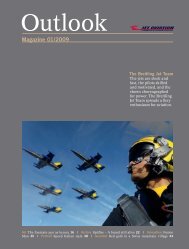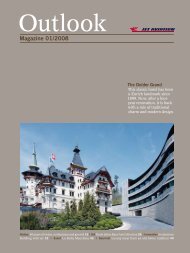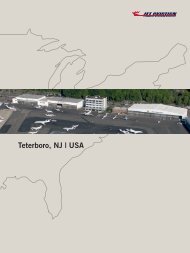profession: pilot career: actor - Jet Aviation
profession: pilot career: actor - Jet Aviation
profession: pilot career: actor - Jet Aviation
Create successful ePaper yourself
Turn your PDF publications into a flip-book with our unique Google optimized e-Paper software.
03<br />
01 The Armadillo engine is tested<br />
02 Evening test firing of the<br />
Bridenstine DKNY Rocket Racer<br />
03 Crew prepping for inaugural flight<br />
04 Bridenstine DKNY Rocket<br />
Racing Team<br />
05 The Armadillo engine installed<br />
on the rocket racer<br />
Teams can make minor modifications to<br />
the avionics and aerodynamics of the air-<br />
craft, but the league wants to keep the<br />
planes very consistent at the beginning.<br />
“We want it to be more about the <strong>pilot</strong> and<br />
team strategy than the vehicle or how<br />
much money a team has,” said Whitelaw.<br />
In the future, he expects teams to be given<br />
more options to customize their aircraft.<br />
He also expects the aircraft to become<br />
stronger, safer, lighter, faster and capable<br />
of longer fuel runs and more acrobatics.<br />
He does not expect the planes to fly more<br />
than 300 miles an hour, because pushing<br />
04<br />
05<br />
speed to the extreme would make the<br />
development and testing of many parts<br />
and technologies impractical.<br />
The business<br />
In addition to its role in promoting the<br />
development of rocket technology, the<br />
league is very much a business venture.<br />
Whitelaw admires the business plan used<br />
by NASCAR and Formula 1.<br />
The brand DKNY Men has become the<br />
first major sponsor and will support the<br />
Bridenstine team, as well as serve as<br />
clothing sponsor for the whole league. The<br />
fashion company wants to promote a line<br />
of men’s suits and hopes that associating<br />
itself with Rocket Racers will boost its<br />
image with men. The league is expecting<br />
more sponsors to follow.<br />
Those interested in starting a Rocket Racer<br />
team can fill in an online form. There<br />
are questions about the level of experience<br />
of the owner, the <strong>pilot</strong>s and the team’s<br />
head of maintenance. At the end of the<br />
form, the prospective owner must also<br />
check a box about his or her available capital.<br />
Choices range from “less than $1M”<br />
to “more than $10M.” To start a team, owners<br />
must buy a $1.25 million kit from the<br />
league that includes the plane, an engine,<br />
avionics, training and the ground support<br />
equipment to refuel and move the aircraft.<br />
“It definitely takes capital to have a team,”<br />
says Marc Cumbow, owner of the Santa<br />
Fe crew. Aside from the initial fee, Cumbow<br />
has invested extensively in research<br />
and development.<br />
He is happy to see that the league has<br />
begun construction on the RRL Aerospace<br />
Business Park in his home state of New<br />
Mexico. The idea behind the business<br />
park in Las Cruces is to develop an industry<br />
cluster where teams and support companies<br />
can locate, similar to Charlotte,<br />
North Carolina for NASCAR and Indianapolis,<br />
Indiana for the Indy Racing League.<br />
The Rocket Racing League hopes this<br />
concentration of technology will benefit<br />
Outlook 02/2008<br />
27







